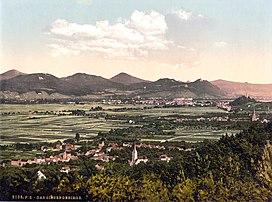geo.wikisort.org - Mountains
The Siebengebirge(![]() German pronunciation (help·info)), occasionally Sieben Mountains or Seven Mountains, are a hill range of the German Central Uplands on the east bank of the Middle Rhine, southeast of Bonn.
German pronunciation (help·info)), occasionally Sieben Mountains or Seven Mountains, are a hill range of the German Central Uplands on the east bank of the Middle Rhine, southeast of Bonn.
| Seven Hills | |
|---|---|
 Seven Hills, 1900 | |
| Highest point | |
| Peak | Großer Ölberg |
| Elevation | 460 m (1,510 ft) |
| Coordinates | 50°40′46″N 07°14′54″E |
| Naming | |
| Native name | Siebengebirge (German) |
| Geography | |
 Area map of Seven Hills
| |
| Country | Germany |
| Region | North Rhine-Westphalia and Rhineland-Palatinate |
| Geology | |
| Orogeny | Volcanic |
| Age of rock | Oligocene |

Description
The area, located in the municipalities of Bad Honnef and Königswinter, consists of more than 40 hills. The hills are of ancient volcanic origin and came into being between 28 and 15 million years ago. Much of the territory covered by Sieben Hills belongs to the Sieben Hills Nature Park (Naturpark Siebengebirge), which is under environmental protection.
The highest peak is the Ölberg at 460 metres above sea level. It is a popular tourist destination for hiking, because of its natural environment.[citation needed]
Hills
The seven most important hills:[citation needed]
- Großer Ölberg (460 m)
- Löwenburg (455 m)
- Lohrberg (435 m)
- Nonnenstromberg (335m)
- Petersberg (331 m, Former name: Stromberg)
- Wolkenburg (324 m)
- Drachenfels (321 m)
Other hills:
- Himmerich (366 m)
- Trenkeberg (430 m)
- Weilberg (297 m)
- Stenzelberg (287 m)
- Broderkonsberg (378 m)
- Mittelberg (353 m)
- Leyberg (359 m)
- Jungfernhardt (320 m)
- Geisberg (324 m)
- Schallenberg (310 m)
- Großer Breiberg (313 m)
- Kleiner Breiberg (288 m)
- Wasserfall (338 m)
- Kleiner Ölberg (332 m)
- Limperichsberg
- Scharfenberg
- Zickelburg (182 m)
Origin name
Although some sources translate the name literally as Seven Hills,[1] where sieben is modern German for "seven" and a Gebirge is a hill range, alternative derivations for the name have been suggested. Three theories exist:
- The oldest name[2] was not Siebengebirge, but Sieben Berge (septem montes, seven hills). Depending on the viewpoint near the river Rhine, one notices almost exactly seven hills, which are not always the same and not even the highest. Also, the number seven used to denote an arbitrary amount of items, was connected to magic and thus had a highly symbolic meaning. This makes it an obvious name for an area that was said to be sinister and impenetrable before the 19th century.
- The word sieben is derived from the word siefen which, in turn comes from the Middle Low German word sîpe "wet depression" or "little stream, brook",[3] the verb sîpen means "trickle, drip".[4]
- The name Siebengebirge emerged from the word Siedengebirge which indicated the presence of soap boilers ("Seifensieder"), who were banned from the valleys because boiling soap smelled so bad.
References
This article needs additional citations for verification. (May 2015) |
- The Castles of the Rhine by Robert R. Taylor (2009). Retrieved 10 Feb 2015.
- Moller, 1590
- Karl Schiller; August Lübben (1878), Mittelniederdeutsches Wörterbuch (in German), vol. 4, Bremen: Verlag von J. Küthmanns Buchhandlung, p. 215
{{citation}}: CS1 maint: multiple names: authors list (link) Digitalisat - See the entry siepen in the Deutsches Wörterbuch.
External links
- Information and pictures about the Siebengebirge
- Rhine Dragon The Seven Mountains: a virtual tour, history, old and new legends, nature
- Honnefer Bilderbogen with pictures of the Siebengebirge
На других языках
[de] Siebengebirge
Das Siebengebirge ist ein rechtsrheinisches, südöstlich von Bonn, im östlichen Stadtgebiet der Städte Königswinter und Bad Honnef gelegenes Mittelgebirge, das aus mehr als 50 Bergen und Anhöhen besteht. Es ist vulkanischen Ursprungs und vor etwa 25,5 Millionen Jahren im Oligozän entstanden. Die letzte vulkanische Aktivität ereignete sich im Miozän und führte zur Entstehung des Petersberges. Das Siebengebirge gehört komplett zum Naturpark Siebengebirge, einem der ältesten Naturparks Deutschlands. Der Schutz ist in einem spezifischen Regelwerk geregelt. Das Naturschutzgebiet Siebengebirge mit noch stärkeren Schutzvorschriften ist etwas enger gefasst, enthält gleichwohl, neben dem nördlich angrenzenden Westteil des Ennert und der sich im Süden ans Gebirge anschließenden Nordhälfte des Rheinwesterwälder Vulkanrückens, das komplette Siebengebirge. Es ist das größte zusammenhängende Naturschutzgebiet Nordrhein-Westfalens. Das Siebengebirge wurde 2006 in die Liste der 77 ausgezeichneten Nationalen Geotope aufgenommen.[1]- [en] Siebengebirge
[fr] Siebengebirge
Les Siebengebirge (littéralement « sept massifs de montagne » en allemand) sont un massif montagneux situé sur la rive droite du Rhin au sud de Bonn. Parmi les collines — en vérité plus de sept —, se trouve le Drachenfels associé à la légende du héros germanique Siegfried ainsi que le Himmerich.[it] Siebengebirge
Le Siebengebirge sono una catena montuosa della Renania Settentrionale-Vestfalia, in Germania.[ru] Зибенгебирге
Зибенгебирге (нем. Siebengebirge, в пер. Семигорье) — горный район в современной средней Германии (ФРГ), северо-западный край Вестервальда[1][2]..Другой контент может иметь иную лицензию. Перед использованием материалов сайта WikiSort.org внимательно изучите правила лицензирования конкретных элементов наполнения сайта.
WikiSort.org - проект по пересортировке и дополнению контента Википедии
